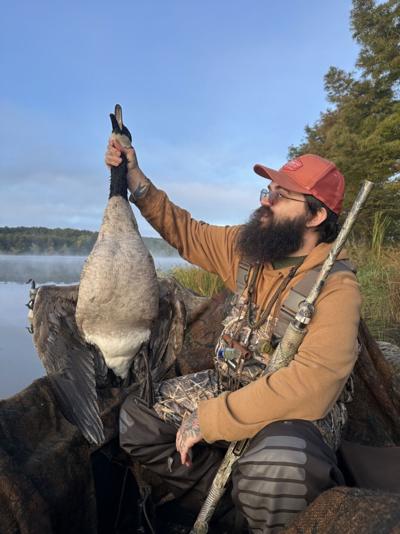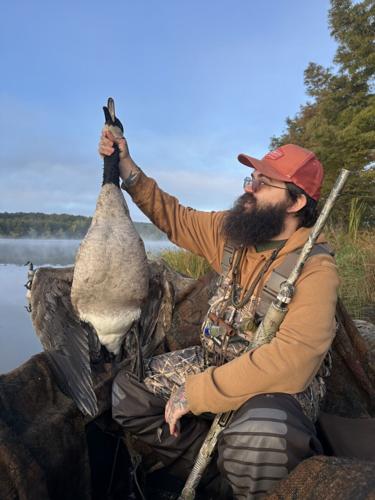Missouri’s early goose season Oct. 4-12, served as an early warm up for waterfowl hunters in the Show-me state. The purpose of Missouri's early goose season is to manage the population of local, resident Canada geese before migratory flocks arrive, using hunting as a tool to reduce their numbers and lessen potential nuisance issues. This early season allows for the harvest of these resident birds before they are joined by geese from northern parts of the continent.
Resident geese have become a problem across Missouri in recent decades as many of the panda-colored birds do not migrate as they once did. Warmer temperatures, later fall weather, and increased food supplies have contributed to the expansion of local flocks, particularly the Giant Canada goose which was once thought to be extinct.
Giant Canada geese were absent from Missouri for decades but began a comeback through restoration efforts starting in the 1940s and early 1950s. Following the rediscovery of a remnant population in Minnesota in the 1960s, conservation agencies like the Missouri Department of Conservation reintroduced them to Missouri using relocated goslings. Today, they are common, found year-round and even considered abundant, populating parks, golf courses, and waterside areas across the state, with massive wintering concentrations at places like Swan Lake, in north-central Missouri, and Sumner in the western part off the state.
The "extinction" and rediscovery
• Historical decline: Like many waterfowl, the giant Canada goose population suffered significantly due to market hunting, egg collection, and habitat loss around the turn of the 20th century. By the 1930s, they were a rarity, and by the 1950s, they were considered extinct by many scientists.
• Rediscovery: A small, isolated flock was rediscovered in Rochester, Minnesota, in the early 1960s, which sparked a major conservation success story.
Restoration and recovery in Missouri
• Early restoration: The MDC began restoration attempts in Missouri in the late 1940s and early 1950s, initially on conservation lands.
• Relocation method: The primary method used was to capture and move young goslings (6-9 weeks old) to new locations.
• Expansion: Restoration efforts later expanded to private lands at the request of landowners.
• Successful adaptation: The geese adapted well to human-altered landscapes like city parks and golf courses, which provided ideal habitats.
• Common and abundant: Today, giant Canada geese are common throughout Missouri and are the most common subspecies found there.
• Year-round residents: Most populations now stay in the area year-round, unlike many migratory geese.
• Local nuisance: Their abundance has led to them being considered a nuisance in some areas due to issues like droppings in parks and on golf courses, with the MDC working to manage these populations.
Local populations of giant Canadas hang out in areas with large open spaces and short grass. They prefer such areas because they like feeding on short grass, and they can see predators from great distances.
A couple of large flocks in St. James rotate between the Soldiers Home, the Walmart Distribution Center, St. James Park and the St. James Golf Course. They become unwelcome guests when they leave droppings on sidewalks and golf course greens. Little is done to manage these flocks, but local hunters do take a few of them when they fly out to area ponds and fields to loaf.
The recent early goose season for Canada geese and Brandt ran from Oct. 4-12, with a daily limit of three and possession limit of 9. Very few hunters actually participate in the early season in this region.
New found friend Corey Manjarrez, Rolla, and I hunted Canada geese together over a three day period at Little Prairie Lake with limited success. I hunted one morning by myself and never saw a single goose. However, I did enjoy two massive flocks of blue-winged teal that sailed into my decoy set. Teal season occurred in early September, so they were off limits. Regular duck season begins Nov. 1, and teal will be legal to take once again.
Manjarrez and I met last year at Little Prairie. We both wanted to hunt the same spot, so we decided to team up. Waterfowl hunting is always a lot more fun with a little company. Waterfowl hunters enjoy telling old tales, comparing calls, shotguns and, of course, shooting abilities. Corey and I hit it off and hunt together every time we run into one another.
During the three mornings we hunted at Little Prairie, we did not encounter any other goose hunters. The lake is not heavily utilized by resident flocks, but they do occasionally visit the larger body of water and loaf for a few hours, before returning to their favored ponds and fields.
We attempt to take advantage of the random arrivals of Canada geese at Little Prairie, but the action is pretty hit and miss. On the slow days is when a hunting buddy comes in handy. At least we have someone to talk to and compare hunting notes with.
A lone goose honked far to the east. Corey answered on his goose call with a few mellow notes. The goose answered, and we felt confident that we could call the lone goose to the decoys. Lone geese are normally easy to decoy, because they are looking for company. For some reason, this particular goose kept on flying and left the lake for another destination.
A bit later in the morning, two Canadas approached from the south. Both of us began calling, and the pair immediately lost altitude, but only one commuted to the decoys. Corey rolled it, and we had our first goose of the early season.
The next day, we enjoyed better success. Numerous small flocks worked the lake, and we managed to take four giant Canada geese. We will both be well set with a Christmas goose.












